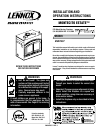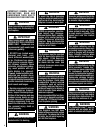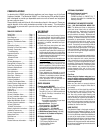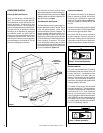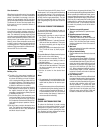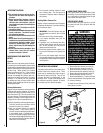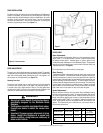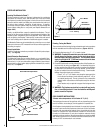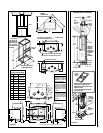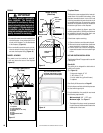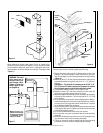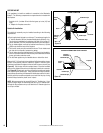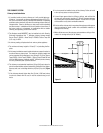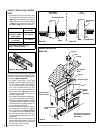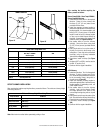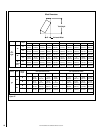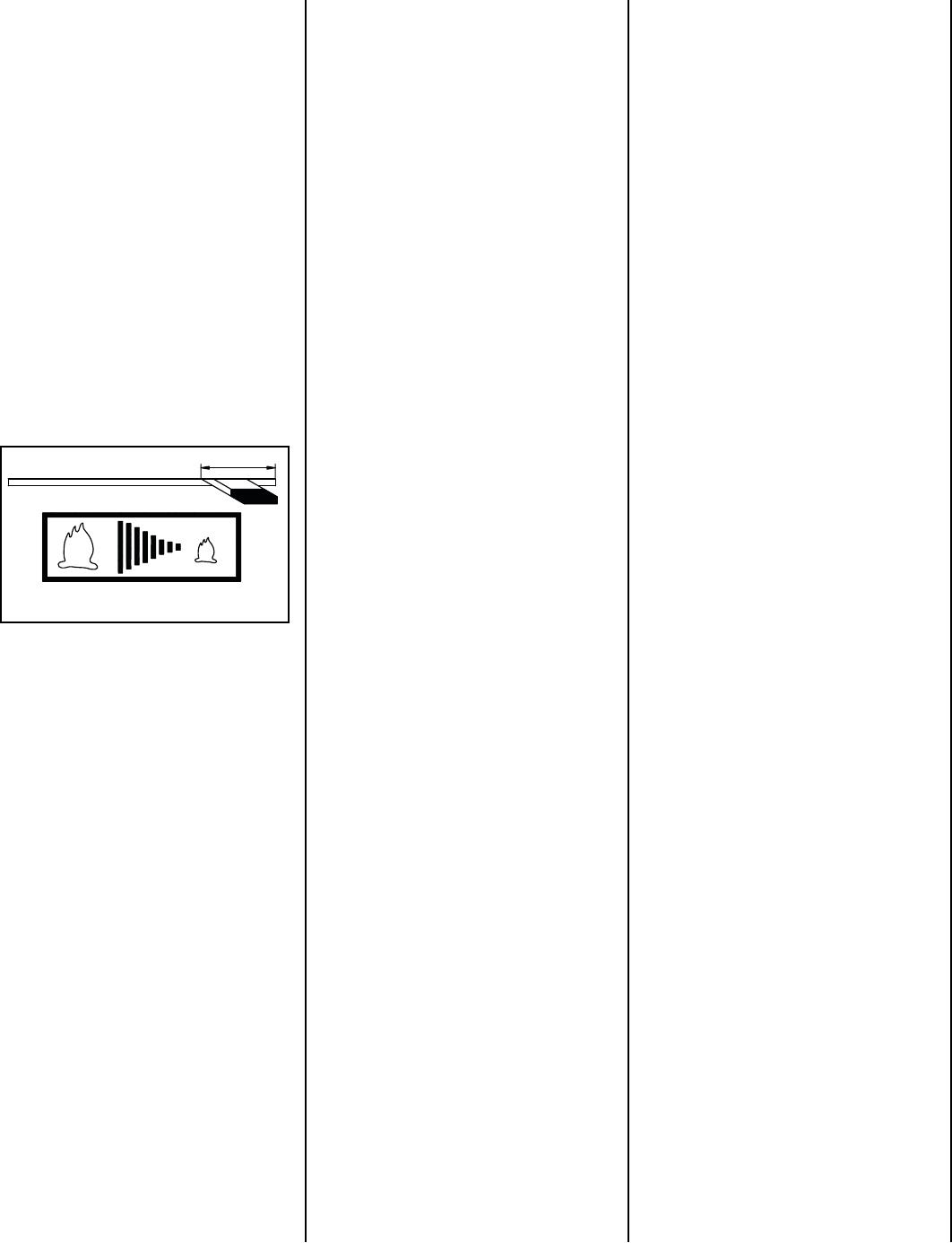
The unit will burn best with 2-3 pieces of cord
wood spaced 1 to 2 inches apart and allowing
air to get under the fuel. Criss-crossing or ar-
ranging the fuel so that air can get underneath
will help the fire to get started easily. The unit
should be operated with the air control fully
open long enough to get the cord wood well
ignited.
REFUELING FOR BEST PERFORMANCE
To reload the Montecito Estate at the end of a
combustion cycle, when no flame is visible and
there are only ashes left:
A) Completely open the air control level and
the T.D.A.B. (Time Delay Air Boost) level.
See Figure 1.
B) Open the doors about 1” and wait 5 seconds
until the air flow has stabilized. Then open
the doors completely, put the logs in and
close the doors.
C) Set the air control to the desired burn level.
The T.D.A.B will close by itself progres-
sively.
To reload the Montecito Estate when the fireplace
is still hot with a few visible flames:
A) Open the air control completely. The T.D.A.B
can be set to a lower setting in order to
facilitate lighting.
B) Open the doors about 1” and wait 5 seconds
until the air flow has stabilized. Then open
the doors completely, put the logs in and
close the doors.
C) Set the air control to the desired burn
level.
Notes:
• For spectacular fire and optimization of the
fireplace efficiency, we recommend that the
wood load be placed as far back as pos-
sible.
• It may be necessary to turn off any blower(s)
in operation during the refueling process in
order to minimise smoking in the room. It
is recommended to wait 15 to 30 minutes
before turning the blower(s) back on to
ensure successful rekindling.
SMOKING –
CAUSES AND TROUBLESHOOTING
To reduce the likelihood of smoke coming
into the room when opening the door, set the
combustion air controls to the left (“Acceler-
ated Combustion”) before opening the door.
Your fireplace has been designed and tested
to provide smoke free operation.
Slow Combustion
When the air combustion control is completely
closed, the fireplace is in a slow combustion
phase. If the hearth is hot enough, slow com-
bustion will not extinguish the fire, but there
will be a noticeable change in the flame pattern.
The flames will be slow and may appear dirty
if the wood is too wet (moisture content of
20% and more).
Do not allow the wood to burn without flame,
since this will produce excessive creosote in
the unit. Creosote may accumulate on the glass
door. This method of burning should be used
only after operating the Montecito Estate™ with
the air control opened to produce a hot fire for
about an hour or at medium pace for at least
three (3) hours. Slow combustion can be used
at night in order to reduce the heat output and
to prolong the burn. The loading time will be
between 6-8 hours and at this combustion rate,
the level of BTU’s is at its lowest.
Building a Fire
A) To start a fire, place several crumpled up
balls of newspaper in the firebox. Place small
dry pieces of kindling on top of the paper,
criss-crossing the kindling so that there are
air spaces in between. The kindling should
be placed at the center of the firebox so as
to allow for sufficient air circulation.
B) Adjust the primary air control and start the
time delayed air-boost system by pushing
the register towards the right. Light the
newspaper. Leave the doors partially opened
to facilitate the start-up.
C) Once kindling fire is well established, cord
wood can be added. You may set the primary
air control to the desire level (see Primary
Air Combustion Control and Air Boost Con-
trols section for proper operation of the air
controls).
D) Set the primary control to the desired burn
level. The fireplace will automatically go to
that level after the fire is fully established
and the air boost is closed.
As the fire burns, air goes up the chimney. This
air must be replaced through the outside air duct.
When operating the Montecito Estate, open a
nearby window temporarily to check if there is
adequate replacement air supply. Occasionally,
there may be a small amount of smoking upon
lighting the fire, until the chimney heats up but
this should not last. If the fireplace continues
to smoke it is probably for one of the follow-
ing reasons:
A. The doors are partially opened
When you open the doors, open them com
-
pletely.
B. Negative pressure in the house
C. Fans operating (e.g.: range hood)
These fans draw air out of the house and
may actually cause a negative pressure in the
house. Turn off all fans and open a nearby
window to determine if this is the cause of
the problem.
D. Wet wood
Wet or tarred wood will smoulder and smoke
instead of burn properly.
E. Dirty or blocked chimney
Check to make sure the chimney is clear and
clean.
F. Chimney not long enough
The minimum chimney height is 12 feet not
including the fireplace height. The chimney
must extend at least three (3) feet (915 mm)
above its point of contact with the roof and
at least two (2) feet (610 mm) higher than
any roof or wall within ten (10) feet (3 m)
of it. When installed with offsets, the mini-
mum chimney height is 15 feet. Additional
height will increase draft and will decrease
the tendency to smoke.
G. Poor chimney draft
With no fire, there should be sufficient draft
to exhaust cigarette smoke introduced under
the baffle. Chimneys installed against an
outside wall without protection may gener-
ate back draft problems which will cause
start-up problems. To prevent this, open
a nearby window; roll up a piece of paper,
light it and hold it in the upper part of the
firebox to warm up the chimney. Wait until
the draft is sufficient, then start the fire.
Figure 4 - Slow Combustion
NOTE: DIAGRAMS & ILLUSTRATIONS ARE NOT TO SCALE.
5



